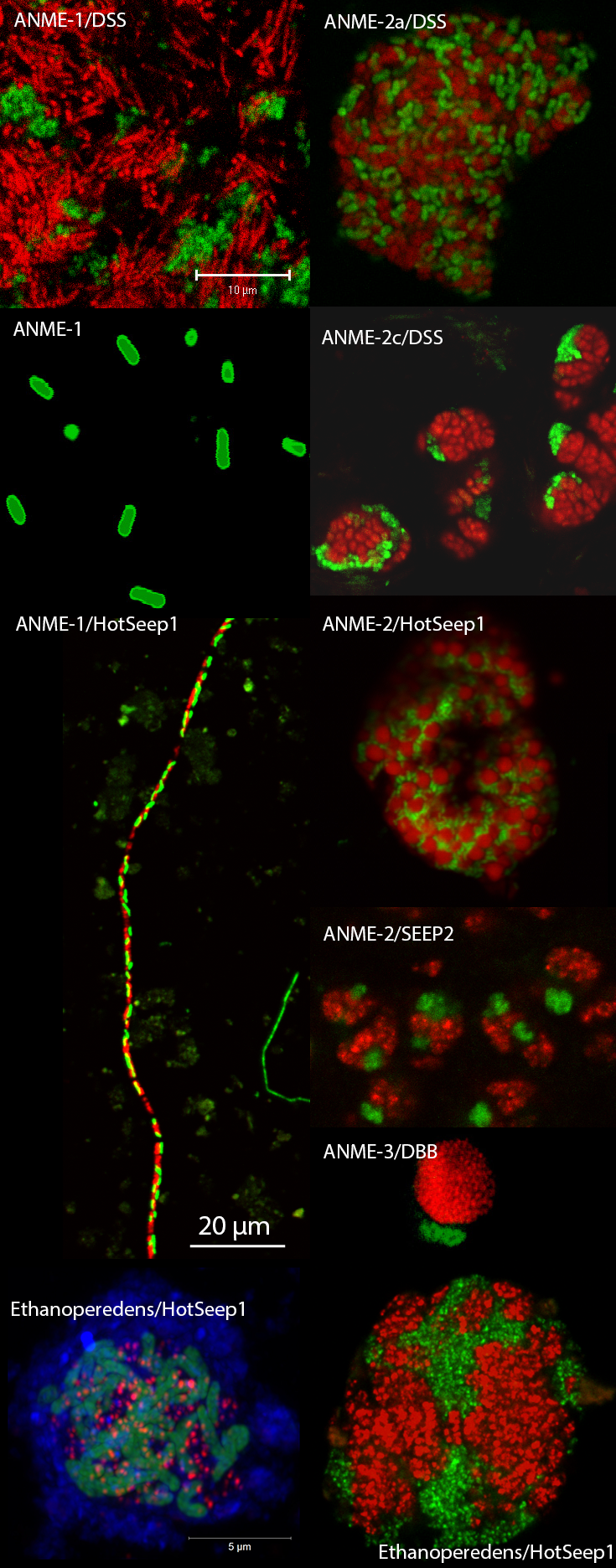Seeps
Project Leader
Project leader
Department of Molecular Ecology
MPI for Marine Microbiology
Celsiusstr. 1
D-28359 Bremen
Germany
|
Room: |
2222 |
|
Phone: |

Our research
We study the ecophysiology of anaerobic hydrocarbon oxidizers and their partner organisms at gas and oil seeps. Abundance, diversity and activity are investigated mainly by probe-based in situ quantification and tag sequencing as well as metabolic pathways and potential intermediates are studied by metagenomics & metatranscriptomics.
In this project we collaborate with the HFG-MPG Research Group for Deep-Sea Ecology and Technology (G. Wegener/A. Boetius) and with the MPG Research Group Microbial Metabolism (T. Wagner).
___________________________________________________________________________________________________
Anaerobic oxidation of alkanes
The metabolic process of the anaerobic oxidation of methane (AOM) is assumed to be a reversal of methanogenesis coupled to the reduction of sulphate to sulphide involving anaerobic methanotrophic archaea (ANME) and sulfate-reducing bacteria (for a review see Knittel and Boetius, 2009).
For about two decades, all cultures known to oxidize non-methane short-chain hydrocarbons anaerobically were bacteria that couple complete substrate oxidization to CO2 and sulfate reduction in one organism (e.g. strain BuS5, Kniemeyer et al., 2007). They activate propane and butane via addition to fumarate yielding alkyl-substituted succinates. The fate of ethane, propane and butane in the environment remained, however, cryptic until the recent description of the butane-oxidizer Candidatus Syntrophoarchaeum by Laso-Pérez et al (2016) and ethane-oxidizer Candidatus Argoarchaeum ethanivorans (GoM-Arc1 clade) by Chen et al (2019). These archaea live, similar to ANME archaea, in a syntrophic association with partner bacteria and use a modified methyl-coenzyme M reductase (MCR) to activate alkanes and form alkyl-CoM as intermediates.
___________________________________________________________________________________________________
Anaerobic oxidation of ethane
In a joined effort with Gunter Wegener we cultured a thermophilic ethane-oxidizing consortium of Candidatus Ethanoperedens and its sulfate-reducing partner bacteria of Candidatus Desulfofervidus (HotSeep1). These consortia grow much faster than any other alkane-oxidizing archaea described before. This allows a fast biomass production and to establish a new model system. A closed genome was obtained and showed the presence of a single, highly divergent MCR likely indicating a substrate specificity for ethane (Hahn et al., 2020).
GoM-Arc1 archaea (Ca. Argoarchaeum and Ethanoperedens) were detected at every ethane-emitting seep site studied (Hahn et al., 2020) and proposed as main drivers in global marine anaerobic oxidation of ethane (AOE). Their novel pathway for ethane oxidation might enable future biotechnological applications by reversing the pathway allowing ethanogenesis from CO2. Current work includes the in-situ detection of mRNA of key genes as well as the biochemistry of key proteins (in cooperation with Tristan Wagner).

Images from Knittel & Boetius, 2010; Hahn et al. 2020 or © Max Planck Institute for Marine Microbiology/K. Knittel
Former members of the project:
Dr. Sara Kleindienst
Dr. Emil Ruff
Dr. Marion Stagars